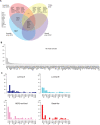Insights into the theranostic value of precision medicine on advanced radiotherapy to breast cancer
- PMID: 33437197
- PMCID: PMC7797538
- DOI: 10.7150/ijms.49544
Insights into the theranostic value of precision medicine on advanced radiotherapy to breast cancer
Abstract
Breast cancer is the most common cancer in women worldwide. "Breast cancer" encompasses a broad spectrum of diseases (i.e., subtypes) with significant epidemiological, clinical, and biological heterogeneity. Each of these subtypes has a different natural history and prognostic profile. Although tumour staging (TNM classification) still provides valuable information in the overall management of breast cancer, the current reality is that clinicians must consider other biological and molecular factors that directly influence treatment decision-making, including extent of surgery, indication for chemotherapy, hormonal therapy, and even radiotherapy (and treatment volumes). The management of breast cancer has changed radically in the last 15 years due to significant advances in our understanding of these tumours. While these changes have been extremely positive in terms of surgical and systemic management, they have also created significant uncertainties concerning integration of local and locoregional radiotherapy into the therapeutic scheme. In parallel, radiotherapy itself has also experienced major advances. Beyond the evident technological advances, new radiobiological concepts have emerged, and genomic data and other patient-specific factors must now be integrated into individualized treatment approaches. In this context, "precision medicine" seeks to provide an answer to these open questions and uncertainties. Although precision medicine has been much discussed in the last five years or so, the concept remains somewhat ambiguous, and it often appear to be used as a "catch-all" term. The present review aims to clarify the meaning of this term and, more importantly, to critically evaluate the role and impact of precision medicine on breast cancer radiotherapy. Finally, we will discuss the current and future of precision medicine in radiotherapy.
Keywords: breast cancer; precision medicine; radiosensitivity; radiotherapy; radiotherapy regime.
© The author(s).
Conflict of interest statement
Competing Interests: The authors have declared that no competing interest exists.
Figures


Similar articles
-
Breast cancer radiotherapy: What physicians need to know in the era of the precision medicine.Breast Dis. 2021;40(1):1-16. doi: 10.3233/BD-201022. Breast Dis. 2021. PMID: 33554881 Review.
-
From technological advances to biological understanding: The main steps toward high-precision RT in breast cancer.Breast. 2016 Oct;29:213-22. doi: 10.1016/j.breast.2016.07.010. Epub 2016 Aug 16. Breast. 2016. PMID: 27542556
-
Precision medicine for early breast cancer radiotherapy: Opening up new horizons?Crit Rev Oncol Hematol. 2017 May;113:79-82. doi: 10.1016/j.critrevonc.2017.03.015. Epub 2017 Mar 18. Crit Rev Oncol Hematol. 2017. PMID: 28427525 Review.
-
Theranostic Advances in Breast Cancer in Nuclear Medicine.Int J Mol Sci. 2021 Apr 27;22(9):4597. doi: 10.3390/ijms22094597. Int J Mol Sci. 2021. PMID: 33925632 Free PMC article. Review.
-
[Evidence-based radiotherapy in the treatment of early-stage invasive breast cancer: traditional clinical features and biomarkers].Magy Onkol. 2009 Mar;53(1):7-14. doi: 10.1556/MOnkol.53.2009.1.2. Magy Onkol. 2009. PMID: 19318321 Hungarian.
Cited by
-
Designing Nanoparticle-based Drug Delivery Systems for Precision Medicine.Int J Med Sci. 2021 Jun 5;18(13):2943-2949. doi: 10.7150/ijms.60874. eCollection 2021. Int J Med Sci. 2021. PMID: 34220321 Free PMC article. Review.
-
Molecular Profile of Important Genes for Radiogenomics in the Amazon Indigenous Population.J Pers Med. 2024 Apr 30;14(5):484. doi: 10.3390/jpm14050484. J Pers Med. 2024. PMID: 38793065 Free PMC article.
-
Strong prognostic value of SLAMF7 protein expression in patients with lymph node-positive breast cancer.Oncol Lett. 2022 Oct 19;24(6):433. doi: 10.3892/ol.2022.13553. eCollection 2022 Dec. Oncol Lett. 2022. PMID: 36311690 Free PMC article.
-
Non-conventional and Investigational PET Radiotracers for Breast Cancer: A Systematic Review.Front Med (Lausanne). 2022 Apr 12;9:881551. doi: 10.3389/fmed.2022.881551. eCollection 2022. Front Med (Lausanne). 2022. PMID: 35492341 Free PMC article.
-
Personalized medicine: Clinical oncology on molecular view of treatment.World J Clin Oncol. 2024 Aug 24;15(8):992-1001. doi: 10.5306/wjco.v15.i8.992. World J Clin Oncol. 2024. PMID: 39193152 Free PMC article. Review.
References
-
- Bray F, Ferlay J, Soerjomataram I. et al. Global cancer statistics 2018: GLOBOCAN estimates of incidence and mortality worldwide for 36 cancers in 185 countries. CA Cancer J Clin. 2018;68:394–424. - PubMed
-
- Amin MB, Greene F, Edge S. et al. The Eighth Edition AJCC Cancer Staging Manual: Continuing to build a bridge from a population-based to a more “personalized” approach to cancer staging. CA Cancer J Clin. 2017;67(2):93–99. - PubMed
-
- Ng CK, Schultheis AM, Bidard FC. et al. Breast cancer genomics from microarrays to massively parallel sequencing: paradigms and new insights. J Natl Cancer Inst. 2015;107:djv015. - PubMed
-
- Ademuyiwa FO, Miller A, O'Connor T. et al. The effects of oncotype DX recurrence scores on chemotherapy utilization in a multi-institutional breast cancer cohort. Breast Cancer Res Treat. 2011;126:797–802. - PubMed
Publication types
MeSH terms
Substances
LinkOut - more resources
Full Text Sources
Other Literature Sources
Medical

